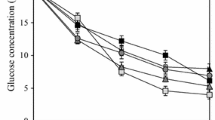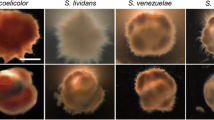Abstract
A native strain of Neurospora sitophila was disrupted using enzymatic pretreatment combined with mechanical disruption in order to facilitate recovery of constitutive cellulases. Exceptional disruption (approaching 100%) was achieved when the enzymatic pretreatment protocol was used prior to mechanical disruption at a low rotor speed via a new bead mill (the Annu Mill). Further, increased recovery of cellulases (ca. two-fold increases in cellulase activity per unit biomass) appears attainable when this disruption protocol is employed. The enzyme preparation employed was Zymolyase, which lyses the walls of viable fungi. Combined disruption of the mycelial biomass appears to provide a secondary source of cellulases from Neurospora sitophila in addition to the extracellular primary source derived from the filtered (unprocessed) fermentation broth.
Similar content being viewed by others
Abbreviations
- CMCase:
-
carboxymethyl cellulase
- FPase:
-
filter paper'ase
- IU:
-
international unit (μmol liberated hydrolysis product/min.)
- N:
-
number of passes through the bead mill (−)
- R:
-
total fraction of cells disrupted (−)
- Ro:
-
fraction of cells disrupted after enzymatic pretreatment alone (−)
- X:
-
cell concentration (dry weight) (gDW/L)
- DW:
-
dry weight
References
Baldwin, C. and Robinson, C.W. (1990). Biotechnol. Techniques, 4, 329.
Bradford, M. (1976). Anal. Biochem., 72, 248.
Brown, J.A., Falconer, D.J. and Wood, T.M. (1987). Enzyme Microb. Technol., 9, 169.
Ghose, T.K. IUPAC. (1987). Pure Appl. Chem., 59, 257.
Heer, D. (1979). Biotechnol. Bioeng., 21, 1361.
Kitamura, K., Kaneko, T. and Yamamoto, Y. (1971). Arch. Biochem. Biophys., 145, 402.
Kitamura, K., Kaneko, T. and Yamamoto, Y. (1972). J. Gen. Appl. Microbiol., 18, 57.
Mao, H.H. and Moo-Young, M. (1990). Biotechnol. Techniques, 4, 335.
Miller, G.L. (1959). Anal. Chem., 31, 426.
Nwabueze, T.U. and Oguntimein, G.B. (1987). Biol. Wastes, 20, 71.
Oguntimein, G.B., Vlach D. and Moo-Young, M. in press. Biol. Wastes.
Oguntimein, G.B. and Moo-Young, M. (1991). W.J. Microbiol. Biotech., 7, 4.
Sauer, T., Robinson C.W. and Glick, B. (1989). Biotechnol. Bioeng., 33, 1330.
Seva, R., Fieschko, J., Sachdev, R. and Mann, M. (1986). Ann. Meeting Soc. Ind. Microbiol, San Francisco, CA.
Updegraff, D.M. (1969). Anal. Chem., 32, 420.
Usami, S., Kirimura, K., Imura, M. and Morikawa, S. (1990). J. Ferment. Technol., 70, 185.
White, M. and Marcus, D. (1988). Disintegration of Microorganisms, in Downstream Processes: Equipment and Techniques, A. Mizahi, ed. p. 52, New York: Alan R. Liss, Inc.
Zetelaki, K. (1969). Process Biochem., 4, 19.
Author information
Authors and Affiliations
Rights and permissions
About this article
Cite this article
Baldwin, C.V., Moo-Young, M. Disruption of a filamentous fungal organism (N. sitophila) using a bead mill of novel design II. Increased recovery of cellulases. Biotechnol Tech 5, 337–342 (1991). https://doi.org/10.1007/BF00185010
Received:
Issue Date:
DOI: https://doi.org/10.1007/BF00185010




